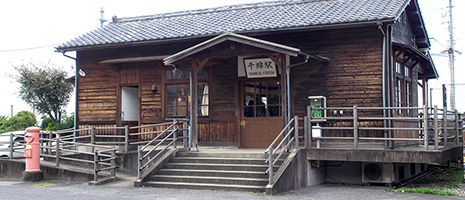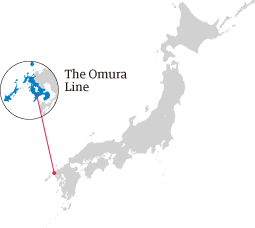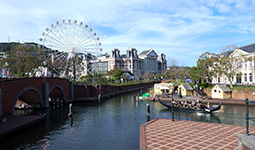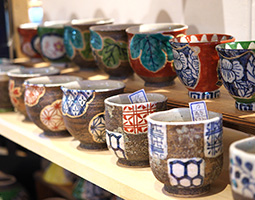Home > Highlighting JAPAN > Highlighting Japan December 2019 > A Trip by Local Train
Highlighting JAPAN


- PREVIOUS
- NEXT
A Railroad at the Edge of a Calm Sea
The Omura Line runs across Nagasaki Prefecture, affording views from the train windows of the calm seas of Omura Bay while connecting passengers with attractions including a theme park recreating European streets and houses, and a traditional porcelain-making town.
The Omura Line operated by Kyushu Railway Company (JR Kyushu) is a 47.6-kilometer railroad line that connects Haiki Station in Sasebo City in northern Nagasaki Prefecture and central Nagasaki Prefecture’s Isahaya Station in Isahaya City. Most of the line runs along the eastern shore of Omura Bay, a large bay situated almost in the center of the prefecture, stretching about 25 kilometers north-south and about 12 kilometers east-west. Because the bay is surrounded by land on all sides except where some parts of the northern shoreline meet the open sea, it is as calm as a lake. Among other beautiful views, the view of Omura Bay stretching out quietly from beneath the train windows in the coastal section of the Omura Line between Kawatana Station and Matsubara Station is particularly enjoyable. Chiwata Station on this stretch of line is well-known for having a fantastic view of the beautiful sunset across Omura Bay, attracting visitors from across the country. Although no station attendants are permanently stationed at the elegant wooden station building, the café Chiwata Shokudo serves drinks, curry and rice featuring local rice and vegetables inside the building.
“The constantly changing colors of the sky are really great. I see the setting sun almost every day, and the colors of the sky change every day. I love the colors of the sky just after sunset very much,” says Yushita Kaori, who manages Chiwata Shokudo with her husband.
There are also special train services on the Omura Line. One of those special trains is Seven Stars (Nanatsuboshi) in Kyushu. Seven Stars, which started running in 2013, is a luxury train that tours around Kyushu. The services include an overnight package and a three-night package. The overnight package, for touring northern Kyushu, is scheduled so that passengers can savor a full-course dinner while feasting their eyes on Omura Bay shining in the sunset.
In addition, the luxury train Aru Ressha makes a round trip, mainly on weekends, between Sasebo Station, situated to the north of Omura Bay, and Nagasaki Station, situated to the south of the bay, by way of the Omura Line. (The operating section may be modified.) Aru Ressha was named after its concept’s initials, “Amazing, Royal and Universal,” and was designed to replicate a train that was first manufactured more than 100 years ago. Passengers on the luxury train can enjoy a course meal supervised by a world-class chef who runs a restaurant in Tokyo. The dishes served use lots of high-quality ingredients produced locally in Kyushu.
There are many tourist attractions, including Omura Bay, along the Omura Line. Japan’s largest theme park, the 1.52 km2 Huis Ten Bosch, is located on the northern shoreline of Omura Bay, just a five-minute walk from Huis Ten Bosch Station. Huis Ten Bosch opened in 1992 and has more attractions than you could possibly enjoy in one day, such as multitudes of flowers displaying the unique colors of each season, famous light displays, and a myriad of entertainments provided every day including attractions featuring the latest technology.
In addition, in the mountains a 20-minute car ride north from Kawatana Station lies Hasami Town, a famous porcelain-making town, and neighboring Arita Town. Hasami ware originated in the early seventeenth century and was mass-produced by more than thirty climbing kilns utilizing the mountain slopes. Hasami ware is largely everyday tableware, such as dishes and bowls, exported to Europe and Southeast Asia during the Edo period (1603–1867), as well as traded in other parts of Japan.
“Hasami ware is characterized mainly by its lightness and strength. Its design, either traditional or modern, is also very attractive,” says Yushita, who uses Hasami ware at Chiwata Shokudo.
Nakaoyama District, which is in the corner of Hasami Town, is a village where about fifteen potters have gathered, and its streets and houses with their brick chimneys exude an atmosphere of a long history. Many works by the potters of Nakaoyama are exhibited and sold at the Nakaoyama Koryukan in the community and you can experience pottery making at the Nakaoyama Denshukan. You can also take an educational tour of the Nakao Climbing Kiln Site, a national historic site and a huge climbing kiln roughly 160 meters in length that had been in use for about 300 years. Lively ceramics festivals that draw many visitors are held at Nakaoyama in the spring and fall.
A trip on the Omura Line gives passengers an amazing opportunity to enjoy both modern entertainment and traditional local culture, as well as the beautiful scenery of Omura Bay.
- PREVIOUS
- NEXT
© 2009 Cabinet Office, Government of Japan









